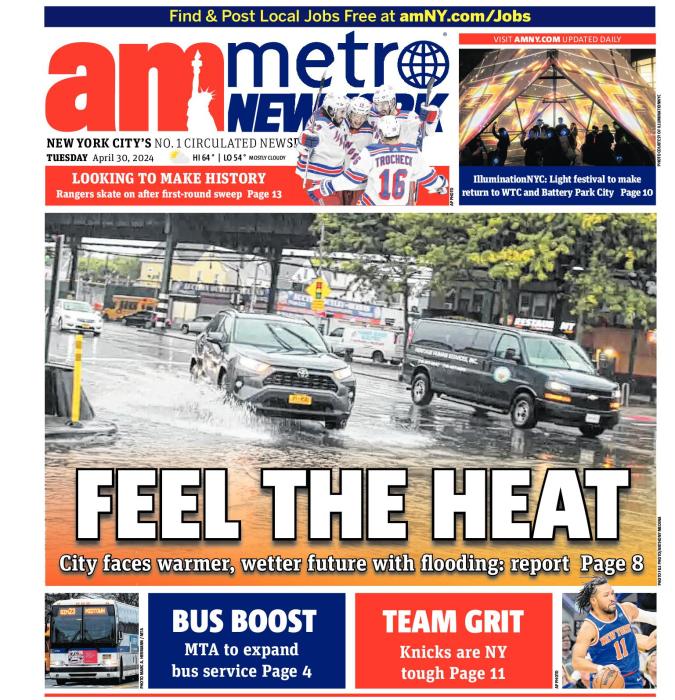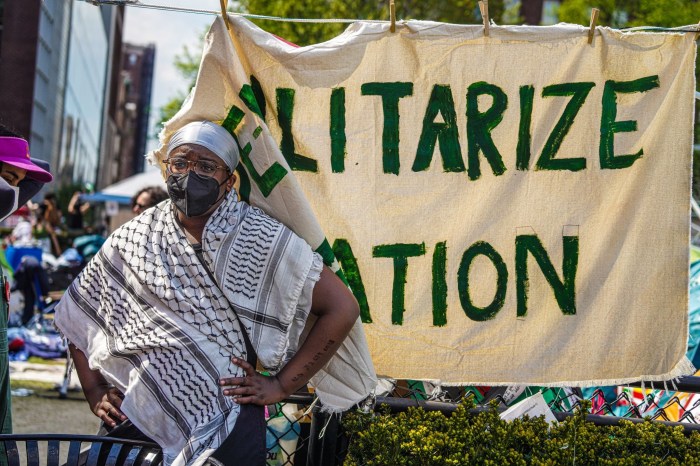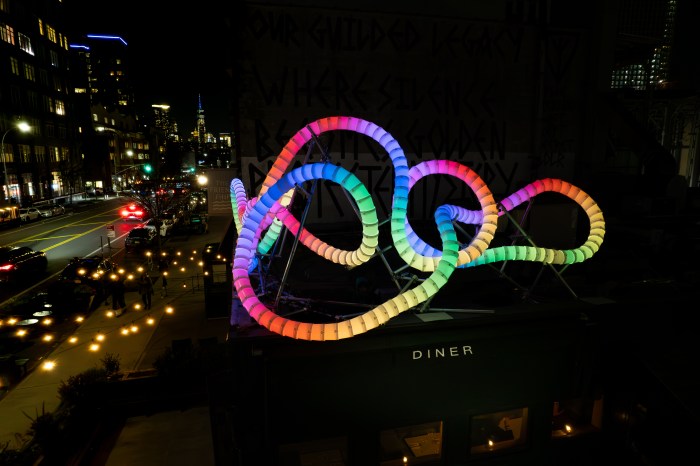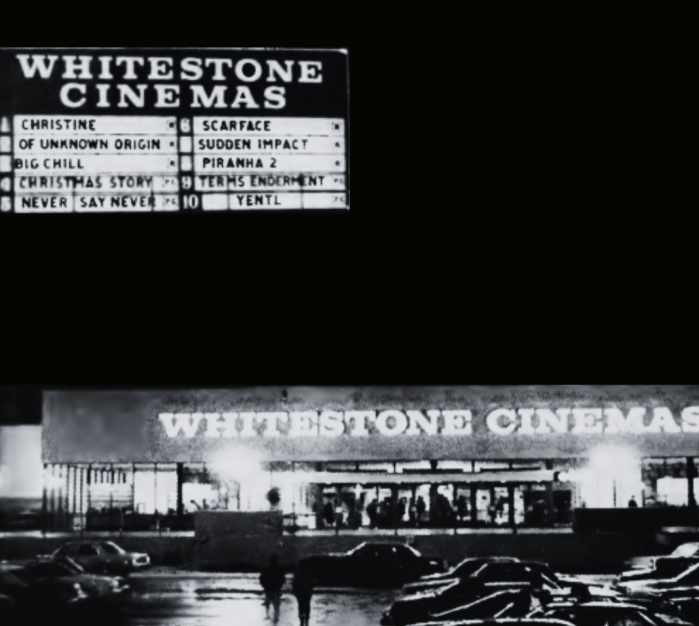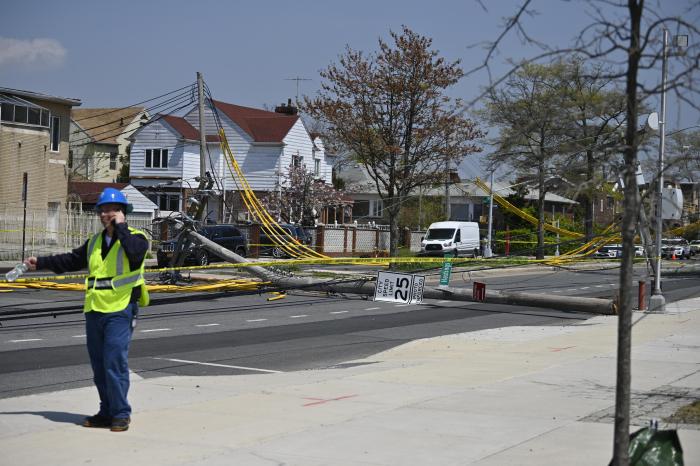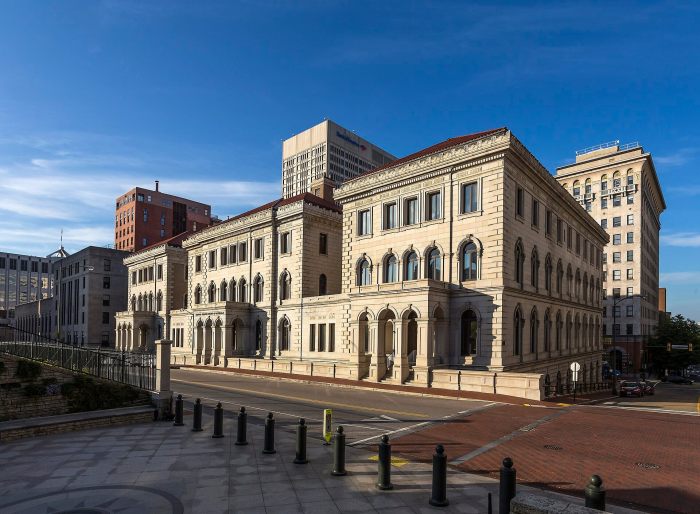BY SCOTT STIFFLER | Epic in scope and length, the June 6 full board meeting of Community Board 4 (CB4) overstayed its allotted time at Fulton Auditorium by a full hour.
The robustly attended 6:30pm meeting, which wrapped up at 11pm, distinguished itself as the point at which CB4’s 14-plus months of contentious public and internal debate regarding the proposed vertical expansion of Chelsea Market came to an end — by way of a final roll call vote on the matter.
Although it took nearly four hours to reach its 26 to 14, “No, Unless” verdict, the full board did manage to hold elections and vote on 26 additional agenda items.
Approaching the podium at 6:32pm, CB4 Chair Corey Johnson asked those who signed up for two-minute Public Session slots to speak loudly and clearly. “The mic is always a little dicey in here,” noted Johnson.
It was the first, and last, understatement in an evening full of strong personal opinions and vocal groupthink expressions.
“Is it my accent?” asked (French) moderator Christine Berthet, who wondered why the 200+ crowd failed to heed her repeated admonishments not to lengthen the proceedings by voicing support or approval after every speaker’s turn at the mic. Berthet’s exasperated comment drew considerable laughs, but little obedience from supporters and detractors of the Chelsea Market expansion — who weren’t satisfied to let their buttons and signs do all the talking.
PUBLIC SESSION COMMENTS
It wasn’t all Chelsea Market matters. Other issues were on the public’s mind.
Two local residents spoke against the elimination of Police Athletic League (PAL) programming. “Children need this after school. We have to keep this open,” said one mother who praised PAL as a necessary source of socialization. Another mother, who went to PAL from ages 8-18 and now sends her three children there, urged the public to call into Mayor Bloomberg’s radio show in protest.
Previewing several upcoming events, the Fashion Institute of Technology’s Lisa Wagner began by citing the little-known fact that FIT is a state college — part of the SUNY system. She then invited the public to The Museum at FIT, which has two new exhibits. Through November 10, “Fashion A-Z, Part Two” displays highlights from the museum’s permanent collection of over 50,000 garments and accessories and 30,000 textiles dating from the eighteenth century to the present. Through July 7, the exhibit “Triangle Factory Fire: Then, Since, Now” will be on view. Created by 26 FIT graduate students in the MFA Illustration program, it’s a visual interpretation of the 1911 Triangle Factory Fire’s impact and aftermath. Located at Seventh Avenue and 27 Street, admission to the Museum is free (open Tuesday-Friday, noon-8 pm and Saturday, 10am-5 pm). For more info visit fitnyc.edu.
Two people spoke in favor of Agenda Item 9 — which would permit the ABA Turkish Restaurant (at 325 W. 57th St., btw. 8th & 9th Aves.) to have a sidewalk café. Self-identified customer Michael Tucker’s words of support were accompanied by letters he brought from six others in the neighborhood. Agenda Item 6 was a more contentious matter. A resident living near Smokey Burger Organic/One Thai Chef (at 339 W. 44th St., btw. 8th & 9th Aves.) expressed concern that fumes from a proposed “smokestack” venting system would blow directly into his building.
Later in the evening, the board — in a series of bundled votes — approved 23 Agenda Items pertaining to letters drafted by the Business Licenses and Permits Committee, the Landmarks Committee, the Transportation Planning Committee, the Executive Committee and the Quality of Life Committee.
Within the context of these bundled votes, CB4 approved Items 6 and 9 — noting that a letter would be sent to the NYC Department of Consumer Affairs supporting ABA’s sidewalk café, and that a letter would be sent to the New York State Liquor Authority recommending a denial of Smokey Burger/One Thai’s request for a wine & beer license unless several stipulations were agreed upon by the applicant (including implementing a mechanical engineer’s recommendations for the rooftop vents to minimize kitchen smells).
REPORTS FROM ELECTED OFFICIALS
When the Public Session concluded (just after 8:30pm), Johnson facilitated the adoption of last month’s minutes as well as the remaining evening’s agenda — which contained 26 scheduled Agenda Items, plus two last-minute additions. With the clock ticking (CB4’s claim on the room expired at 10pm), Johnson announced that the usual time spent hearing reports from the representatives of elected officials would be abbreviated. He referred those interested in further details to a table containing stacks of handouts from the electeds.
Several reps spoke briefly. Jessica Silver — Manhattan Borough President Scott Stringer’s Director of Community Affairs — introduced David Czyzyk as “our new liaison to Community Board 4.” Silver also noted that after CB4 weighs in on Chelsea Market, “It’s coming to our office” as the next step in the process of vetting Jamestown Properties’ Uniform Land Use Review Procedure (ULURP) application. Once Stringer issues his own recommendation, the ULURP application goes to the City Planning Commission, and is then either approved or rejected by the City Council — whose decision is subject only to mayoral override.
“We’ve had staff at every CB4 meeting where Chelsea Market has been discussed,” Silver noted, assuring the crowd that the borough president would carefully consider all of the issues raised by the board and the community.
Jeffrey LeFrancois, from Assemblymember Dick Gottfried’s office, reiterated, “Senator Gottfriend opposes the expansion of Chelsea Market.” Sarah Malloy-Good, representing Deborah Glick, noted that the senator “opposes expansion, even with the minor modifications.”
A detailed handout brought to the meeting by representatives of Quinn’s office (“Speaker Christine C. Quinn Reports to Community Board 4: June 6, 2012”) noted, “My office recently met with a group of residents that live in close proximity to the Bowery Residents Committee’s (BRC) building to discuss the quality of life issues they were dealing with. Following up to that meeting, the BRC has agreed to pursue and apply for paid detail through the NYPD. These new improvements will provide residents with the light and security presence necessary to improve safety on the street. There is work to be done, but these are critical steps in the right direction.” Later in the evening, CB4’s approval of Agenda Item 23 endorsed the Housing, Health and Human Services Committee’s letter to the BRC and the Department of Homeless Services — which also addressed the matter of a dedicated security team for the BRC’s West 25th Street facility.
ELECTIONS
Five candidates, running unopposed, were elected or re-elected to their positions — and will serve until the current term expires on December 31, 2013. Chair Corey Johnson and secretaries Larry Roberts and Evangeline Gomez received all 42 votes. Christine Berthet received 41 votes, to retain her position as First Chair (the remaining vote was a write-in). Paul Seres, who decided not to run for Second Vice Chair, was succeeded by Burt Lazarin (swept into office by a unanimous 42 votes).
PUBLIC DEBATES CHELSEA MARKET
Of the 62 people who arrived early to sign up for two-minute Public Session slots, 57 spoke on the matter of Chelsea Market expansion — 24 in support, 33 against.
CB4’s policy of accommodating everyone who arrives to participate in the Public Session allowed many of those who’ve been following the Chelsea Market vetting process to have one final say for or against expansion.
Over the next two hours, commentary from the usual suspects (Save Chelsea, the Greenwich Village-Chelsea Chamber of Commerce, Friends of the High Line, the Greenwich Village Society for Historic Preservation, tenants from the Robert Fulton Houses) was interspersed with an unprecedented showing of support from Chelsea Market merchants.
Ed Kirkland, a former co-chair of CB4’s Landmarks Committee, declared the Jamestown Proposal “bad for the High Line. It’s bad as a gentrifier. It’s bad for historical preservation. We all want affordable housing, but this is not the way to get it.” Longtime Chelsea resident Larry Lippman — speaking as a representative of the Chelsea Coalition on Housing — implored the board to ensure that any new development be “built to human needs. Let’s leave it [Chelsea Market] that way. Listen to the community. Vote ‘No’ to expansion.”
Testimonials from Chelsea Market tenants focused exclusively on how Jamestown recruited them as tenants, negotiated satisfactory leases and helped them grow — providing a strong rebuke to those who’ve long argued that Jamestown Properties seeks only to nurture profit for the benefit of its investors.
Jake Dickson, of Dickson’s Farmstand Meats, recalled how his butcher shop opened in 2009 as a one-person operation selling out of a pickup truck in the Village — and now resides in Chelsea Market as a business which just hired its 15th employee. “More people in the building,” he said of the 1,000 workers that would populate additional office space atop the market, “allows us to invest more in our businesses.”
Janet Torres, Vice President of the Robert Fulton Houses Tenants Association, made similar arguments, noting that her organization “fully supports Chelsea Market expansion. It will add 60 union construction jobs.” Referencing the presence of more workers commuting into the area, Torres asserted there would be a ripple effect felt beyond the concourse. “An extra one thousand people working in Chelsea Market,” she said, “will mean more dollars spent on our local businesses.”
But not all were convinced that Jamestown’s altruistic overtures will endure. Other speakers alluded to the fact that the company’s public declarations to protect the integrity of the market’s concourse still left the door open to reduce the presence of food-oriented businesses from the present amount (85 percent) to as little as 50 percent.
Those who showed up to oppose the plan made the case that no amount of economic benefit to the area justifies the irreparable damage that vertical expansion would inflict upon the iconic Chelsea Market building — although later, when CB4 debated the matter, Joe Restuccia pointed out that as is, Chelsea Market is in “a manufacturing zone. It can be demolished tomorrow.”
To ensure such a scenario doesn’t occur, Julie Menin spoke during the Public Session. “I am not here as chair of CB1,” Menin assured. Nevertheless, she did reference her years of experience to implore CB4 to remember that, “Our job as Community Board members is to make sure development is contextual…that we are careful stewards of the neighborhoods in which we live. I believe the Community Board should recommend the building for landmark designation.”
Following the Public Session, Jamestown Land Use Lawyer Melanie Meyers (during a slideshow presentation on design options for the façade) spoke to Menin’s concerns regarding contextual development — noting that Jamestown was “prepared to commit to the exact presentation we gave May 31.”
That presentation, given at the CB4 Chelsea Preservation & Planning Committee (CPP) meeting, presented new renderings for massing changes on the Ninth Avenue side of the project as well as an overall design shift from an “expressive steel structure” to a terracotta look that was in keeping with the style of nearby structures.
Meyers also reiterated Jamestown’s commitment to other concessions and community “gets” arrived at during the May 31 CPP meeting. These included retaining the 240,000 square feet of office space on Tenth Avenue, while eliminating the proposed 90,000 square foot hotel on the Ninth Avenue side (and replacing it with closer to 70,000 square feet of office space). Jamestown voiced its willingness to accept a binding requirement that at least 50 percent of the concourse retail businesses be devoted to food-oriented establishments. “We’re amenable,” Meyers said, to a training/technology lab to give nearby residents the skills necessary to obtain employment in the newly created office space.
In an email to Chelsea Now after the June 6 meeting took place, Jamestown clarified their position on supporting landmark status for Chelsea Market, noting they would do so “with the stipulation that the proposed project would move forward without LPC review and it allowed changes of the type that Chelsea Market has done over the last fifteen years like rooftop equipment, small additions, ground floor storefronts, changing out windows, etc.”
In order to secure the Zoning Map change and the Zoning Text Amendment necessary for the project to be realized, Jamestown also indicated (to the CPP and the full board) that they would be amenable to the most significant additional public benefit to come out of the May 31 meeting: A request that (as noted by CPP co-chair Lee Compton) “twenty-seven percent of the square footage of any enlargement on the block be matched by Affordable Housing in Chelsea” or the CB4 area of coverage. As proposed by CPP (and later backed by the full board), Jamestown’s funding for Affordable Housing would be in the form of a donation on top of the $17-$19 million currently earmarked for the High Line.
Many members of the public, whose resentment of High Line enrichment at the cost of Chelsea Market expansion has grown from a simmer to a boil, found this a palatable addition to a flawed proposal. “What is this business of the High Line being like Tony Soprano,” asked Claudia Dreifus, a Chelsea resident since 1967. “You pay us off, and we’ll testify for you. Many executives of the High Line are getting high six figure salaries. What are we [the community] getting out of this?”
BOARD DEBATES CHELSEA MARKET
After the Public Session and a brief presentation by Jamestown, CB4 members began to tip their hands as to whether they intended to support the “No, Unless” Letter of Recommendation submitted to the full board by CPP.
Chair Corey Johnson said, “I’ve thought long and hard on ways we can support this proposal. But in the end, I’ve decided an unequivocal ‘No’ is the best vote for me. I’ve listened to the community, I’ve heard the community and I am part of the community.”
Johnson’s comments set in motion a debate on whether it was nobler to take an uncompromising “No” position, or reach the same compromise as CPP — whose “No, Unless” achieved significant concessions from Jamestown seen as beneficial “gets” to the surrounding community.
That sea change from defiance to accepting the inevitable was best articulated by Clinton/Hell’s Kitchen Land Use Committee Co-Chair Jean-Daniel Noland — who noted, “If we say ‘No,’ we don’t sit at the table. Anything that gets certified by City Planning gets built. We have to face reality. It will go to the Borough President. He will sit down with the developer and make a deal, just like he did with NYU. The City Council; do you think they’re going to vote against jobs? They’re gonna build this thing. We could do worse. We’ve got to do something.” Referencing the CPP Letter of Recommendation, Noland said, “This is one of the strongest and toughest letters I’ve ever seen.”
Pamela Wolff was not swayed, however. Her motion for a Substitute Resolution, a “No, Because” verdict that made a lengthy and detailed case for rejecting the Jamestown plan, was itself rejected (18 votes in favor, 24 against).
Ultimately, CB4 issued a “No, Unless” verdict (26 in favor, 14 against), with one amendment added to the CPP’s Letter of Recommendation (a request that Jamestown Properties provide financial support to area public schools).
For more information, visit nyc.gov/mancb4. For Facebook: facebook.com/ManhgattanCB4. For Twitter: twitter.com/#!mancb4. For Linkedin: linkedin.com/pub/commuity-board-4-manhattan.
NOTE: The article was updated, online, at 9:45pm on June 13, to clarify Jamestown’s position regarding its support of landmark status for Chelsea Market.
